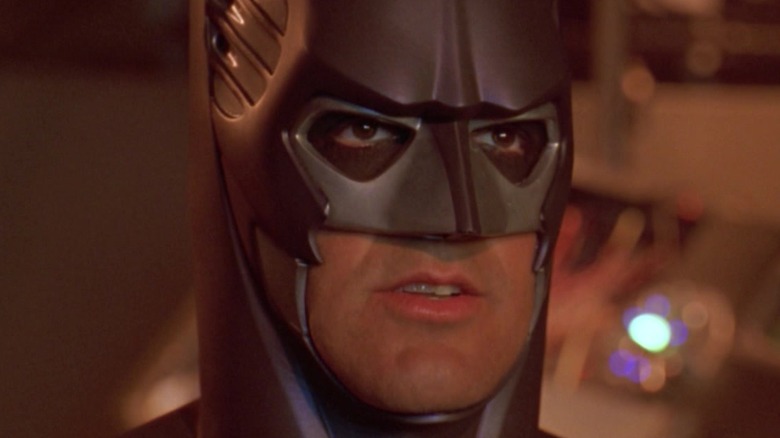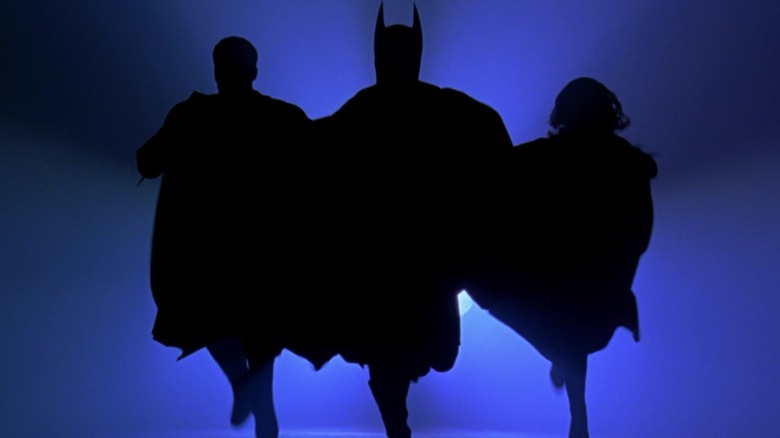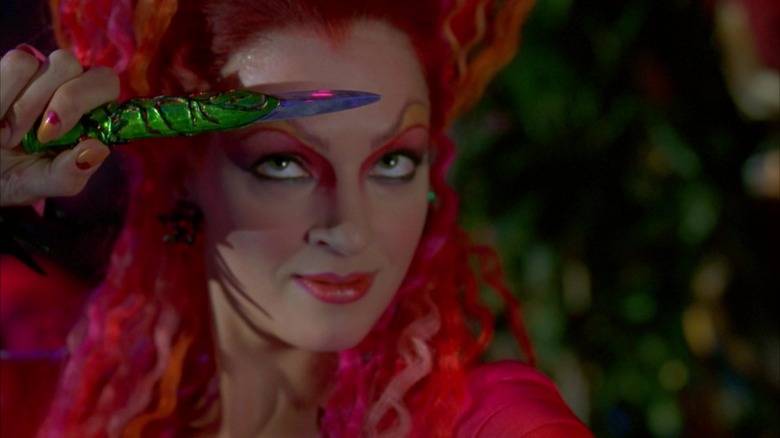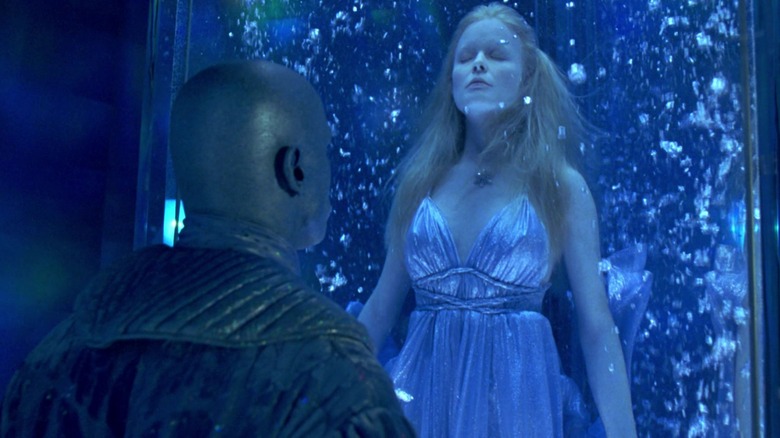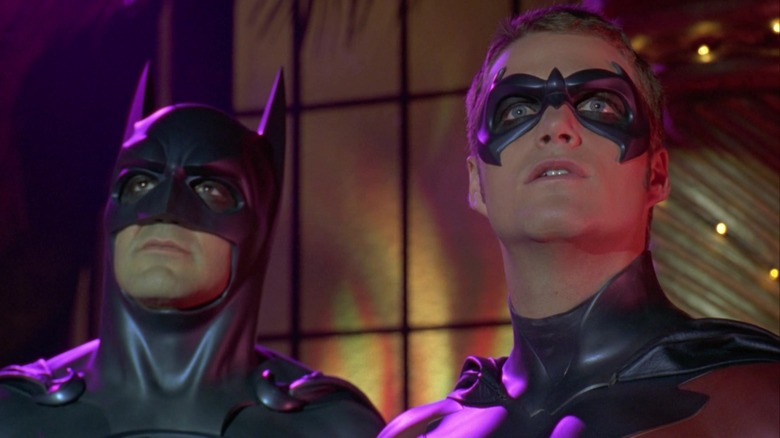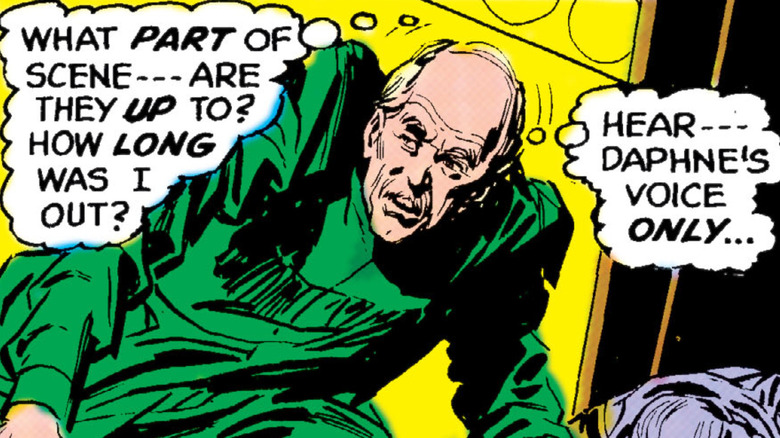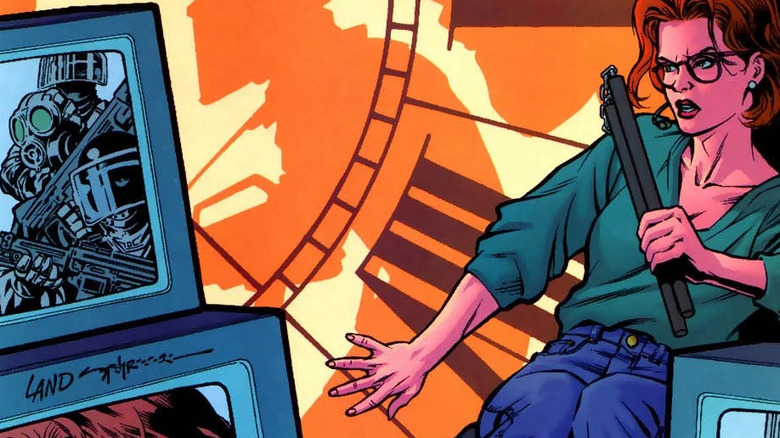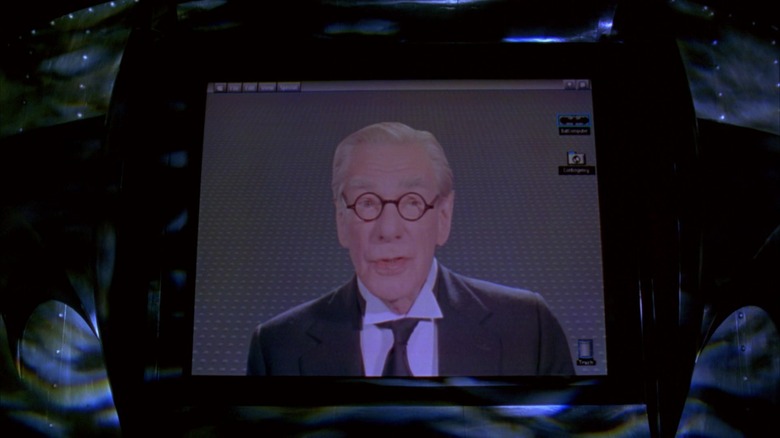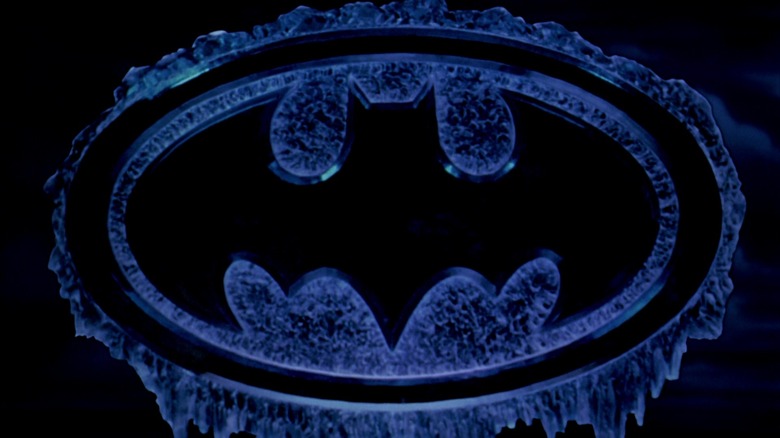The Ending Of Batman And Robin Explained
"Batman & Robin," the final entry into the series of "Batman" movies directed by Tim Burton and later Joel Schumacher, may be the most divisive of the four films. Despite its flaws, who can forget its memorable ending? Batman in silhouette runs in front of the Bat-Signal while Batgirl — his newest ally in the war on crime — and Robin join in from the sides, racing off to another adventure.
With the film's central villains Poison Ivy and Mr. Freeze incarcerated and Alfred Pennyworth cured from the near-fatal disease afflicting him throughout much of the movie, the finale of the 1997 critical catastrophe isn't exactly what anyone would call murky or ambiguous. Yet there are a few elements that are still worth shining a Robin-Signal on. Was the final scene meant to provide genuine closure, hinting at a new chapter of the Caped Crusader's life that was never intended to be told onscreen? Or was it meant to set up new "Batman" movies also featuring Robin and Batgirl further down the line? Put on your best superhero suit, and keep in mind rubber nipples are optional as Looper is finally here to explain the ending of "Batman & Robin."
A new beginning
One could easily be forgiven for thinking the Bat-Signal run in the final scene of "Batman & Robin" implies that more is coming. At one point, that was the plan. As The Hollywood Reporter explains, two versions of a fifth "Batman" movie almost went into production, both with the Scarecrow envisioned as a main villain. One was "Batman Unchained," in which the self-stylized Master of Fear uses his fear toxin to trick Batman into thinking he's fighting villains from the first three films reprised by their original actors. The other was "Batman: DarKnight," in which the Caped Crusader leaves crimefighting behind until the Scarecrow makes Robin both a test subject and Arkham inmate. Despite their different premises, the two films had many similarities, including the inclusions of Harley Quinn and Robin. Surprisingly, Batgirl is absent from both scripts. Significant differences include Man-Bat's appearance as a major villain in "DarKnight," Joel Schumacher only being attached to direct "Unchained," and the intention to use "DarKnight" as the beginning of a trilogy.
Ultimately, neither movie made it all that far out of Hollywood's metaphorical Batcave. It's a pity, in a way, given the major stars being considered included Courtney Love for the role of Harley Quinn and both Nicolas Cage and Coolio — the latter of whom appears in "Batman & Robin" — as candidates for the Scarecrow.
Things probably didn't end well for Poison Ivy
Plant life and frigid temperatures don't often mix well, but Poison Ivy certainly seems to think otherwise, at least enough to propose an alliance with cold-themed baddie Mr. Freeze. Yet as is common for Batman villains, Ivy proves a duplicitous ally. After she joins criminal forces with Freeze, she tries to murder his wife Nora, who she thinks might get in the way of Freeze's romantic affections, by disconnecting her suspended animation chamber. Once Freeze learns what Ivy's done, he becomes hungry for vengeance. In their final scene together, Ivy learns revenge truly is a dish best served cold when Freeze appears in her cell in Arkham, eager for payback. Worse still for Ivy, Freeze still has his armor, while Ivy has no mutated plants around and no hypnotic pheromone dust that works on Freeze. She has no way to even the odds.
The outcome of their encounter is never shown, but Poison Ivy's chances of victory are slim. Unlike in the comics, villains don't necessarily have a high rate of resurrection in Burton and Schumacher "Batman" movies. Freeze never clarifies whether he intends to kill Ivy, and there's always a chance Ivy does make it out alive. Maybe she's got a poison kiss somewhere up her sleeve? That said, the chances of Ivy successfully planting a smooch on Gotham's coldest citizen aren't favorable.
Renewed hope for Nora Fries
Taking inspiration from "Batman: The Animated Series," Mr. Freeze's driving motivation behind his crimes in "Batman & Robin" is funding research to cure his wife Nora, who suffers from a fictional ailment the film calls MacGregor's Syndrome — a disease that's lethal in its later stages. At the start of the movie, Nora's condition has no cure, which becomes a very personal problem for Batman, Robin, and Batgirl when longtime Wayne Manor butler and Bruce Wayne's surrogate father figure Alfred Pennyworth also comes down with the disease.
Fortunately, Batman learns that Freeze's research efforts have actually been productive, as the villain has developed an antidote for the first stage of the disease. Freeze's cure only works on Alfred — Nora's case is much more advanced — but the fact that Freeze survives allows him to continue his research. The possibility remains that one day, he can save Nora's life and remove her from the chamber he designed to halt the disease. They might even be able to pick their relationship up where it left off ... assuming Nora doesn't reject Freeze for his history of super-crime, that is.
Strengthened bonds
The forging of Batman and Robin's partnership is one of the core storylines in 1995's "Batman Forever." But in "Batman & Robin," the Dark Knight still doesn't entirely trust his crimefighting partner to handle things himself — an instinct that's pretty much validated by Robin's occasional bouts of recklessness. The two characters' bond comes under even greater strain when they meet Poison Ivy, whose pheromone dust turns the Dynamic Duo into rivals for Ivy's affections.
Thankfully, Batman figures out Ivy's methods and helps Robin realize they're being manipulated against each other. From there, their partnership begins to improve, culminating in Batman actually letting Robin save himself from a fall off the Gotham Observatory during their final fight with Freeze. Of course, Robin bungles his self-rescue, and it falls upon Batgirl to zip him to safety, but at least Batman intended to give Robin more independence. Batman placing more faith in Robin's abilities finally resolves the tension between the two, promising a healthier partnership going forward. That's not to say a later schism between Batman and Robin is out of the question; after all, Robin's costume heavily resembles that of Nightwing, the superhero identity Robin takes on in the comics after he decides to move away from Gotham and out of Batman's shadow.
Alfred still has a brother out there
While his health remains embattled thanks to his struggles with MacGregor's Syndrome, Alfred prepares a CD-ROM with various information and schematics related to the Dynamic Duo, under the pretext that his elusive brother Wilfred should succeed him as Batman and Robin's butler and crimefighting aide. While the film seems to subtly suggest that Alfred actually intends for his curious niece Barbara Wilson to read the CD instead, that doesn't mean that Wilfred still isn't out there somewhere in the world. During the pre-"Crisis" era of DC Comics, Alfred does indeed have a brother named Wilfred — an actor whose daughter Daphne shares more than a few things in common with the version of Barbara we see in "Batman & Robin." Could Wilfred still be out there in the "Schumacher-verse," perhaps destined to one day rejoin his brother and help Gotham's most famous crimefighting team? We may never know, but should the Schumacher films one day be revisited, as unlikely as that sounds, the emergence of Wilfred could always be in the cards.
An Oracle in the wings?
Batgirl, aka Barbara Wilson (though it's Barbara Gordon in the comics), plays an instrumental role in saving Gotham City in "Batman & Robin," hacking into several satellites so she can use sunlight from around the world to melt the ice encasing Gotham City. Barbara's computer skills, also alluded to earlier in the film, likely provoked some major feelings of déjà vu in comic book fans. Barbara famously becomes the master computer hacker Oracle in the comics after a spinal gunshot wound removes her ability to walk. She even returns to the identity of Oracle following her recovery, as fighting crime regularly can be a little rough on spinal implants, plus there are at least two other Batgirls running around Gotham who can pick up the slack.
While the door to a sequel to the Schumacher films seems closed for now, turning Barbara into Oracle is certainly a possibility should that world ever be revisited. Though some might argue she spent too little time as Batgirl to abandon the identity so quickly, recent comics have proven that Barbara is more than capable of using both identities simultaneously.
Two Alfreds
Like his niece, Alfred from "Batman & Robin" proves he's no slouch in the computer programming department. Not only does he manage to devise a CD with a robust and highly visual set of data in it, especially by 1997 standards, but he goes one step further and creates a computer AI version for himself to guide Batman, Robin, and Batgirl in the event of his passing. Barbara is the first to learn of Alfred's AI replica, who helps prepare her for her first costumed crimefighting mission.
Alfred is cured at the end of the movie, but nobody says anything about deleting his computer duplicate. While the AI could have simply been put away for the next time the flesh-and-blood Alfred requires a substitute, there's no reason why both Alfreds can't be active members of Batman's crimefighting team. AI Alfred has the knowledge of the original and the Batcave's computer system at his disposal, while the human Alfred can do all the things in the physical world a computer program cannot.
It wasn't just the end of a movie
Mr. Freeze may have wanted to put Batman on ice, but that's certainly not what the filmmakers wanted to do with the Caped Crusader's film franchise. Still, reviewers apparently just weren't that into ice puns, retractable ice skates, and the return of the rubber nipples from "Batman Forever." Furthermore, while the movie's weekend money pull remained in the top 10 roughly a good month into its run, it was knocked out of first place by both Disney's "Hercules" and John Woo's "Face/Off" a week after its debut and kept sliding downward, ultimately winding up as the summer's sixth highest grossing film. It made a profit, but less than "Batman Forever," and not even some solid early video sales could keep Batman's future movie prospects from being put in deep freeze. Gotham's guardian wouldn't be thawed out until eight years later when Christopher Nolan rebooted the franchise with "Batman Begins" in 2005.
The finale of "Batman & Robin" doesn't just end a movie; it closes out an entire era of Bat-movies. While the Burton-directed "Batman" films have been revisited in the comic "Batman '89," and Michael Keaton's return to the role of Bruce Wayne in upcoming DC projects indicates they may be revisited on the big screen as well, no one's picked up from where Joel Schumacher left off. Perhaps one day someone will dig Schumacher's Neon Knight and his crimefighting partners out from "deep beneath the snow" and finally give the "Batman & Robin" saga a proper continuation.
